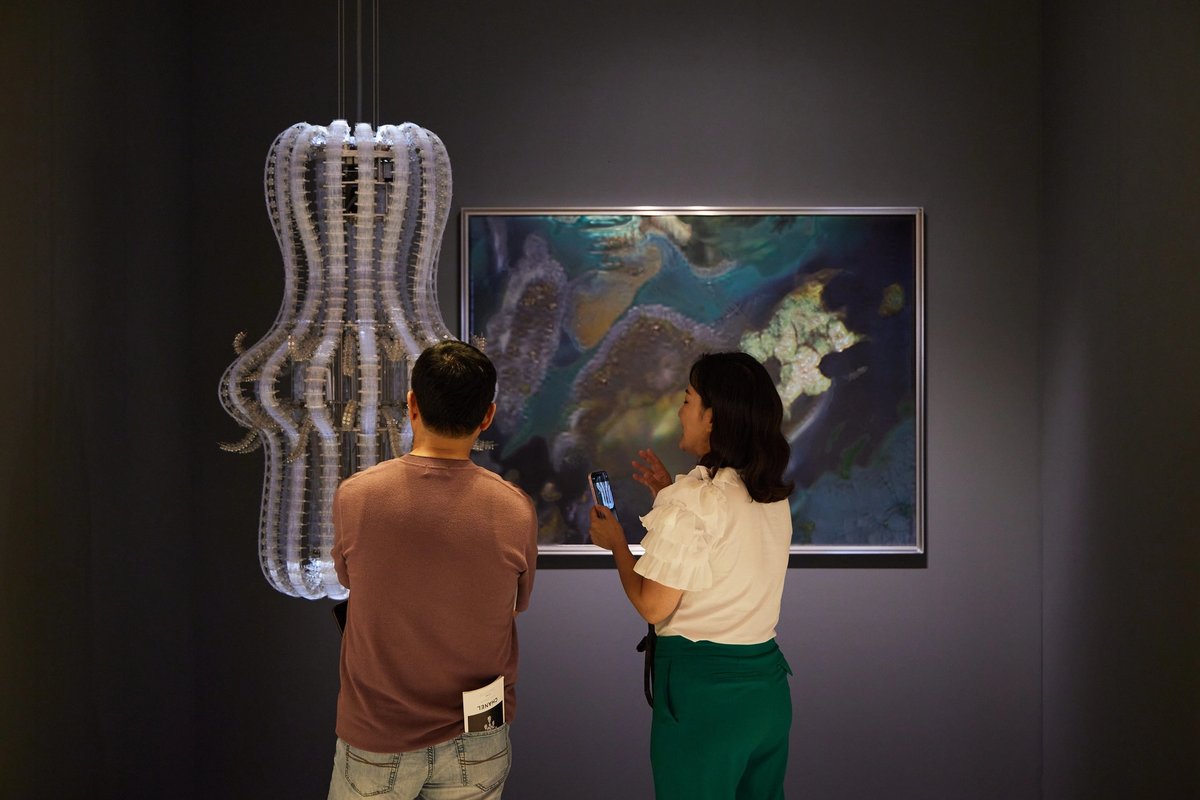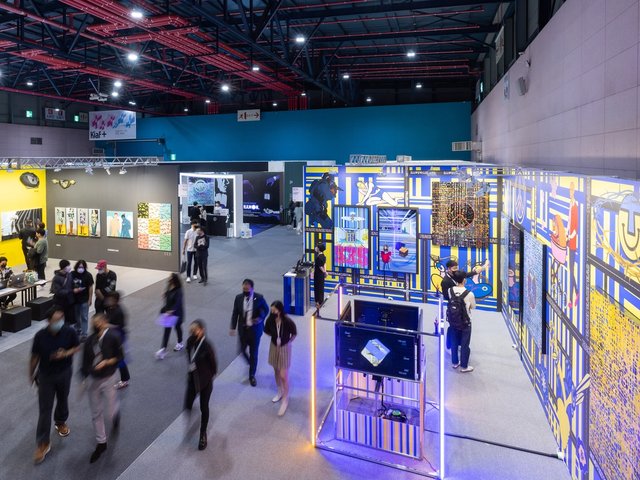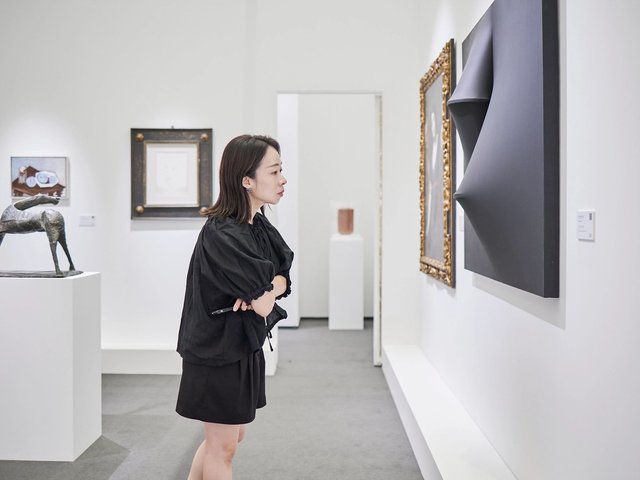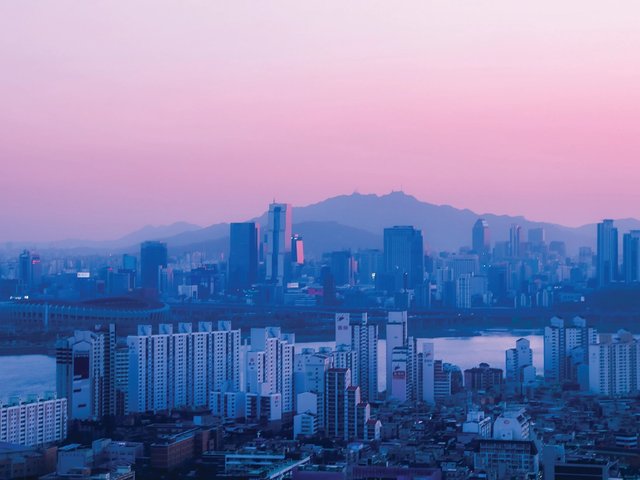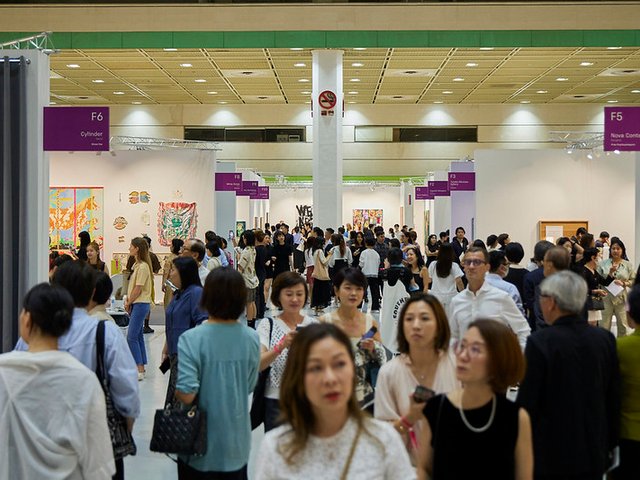At yesterday's VIP preview of the third edition of Frieze Seoul (until 8 September), moderated expectations, due to an economic slowdown in South Korea, were met accordingly by moderate sales. The fair features 117 galleries and is held concurrently with the partner fair Kiaf, which welcomed 207 exhibitors to its 23rd edition.
This is not to say the energy at either fair was muted: the events received a welcome boost of visitors and attention thanks to the inaugural editions of Seoul Art Week (SAW) and Korea Art Festival (KAF), which run alongside the fairs. Frieze Seoul's director, Patrick Lee, told The Art Newspaper: “Everyone who's come has seen amazing exhibitions. The energy’s there, people are enthusiastic, and that definitely spills over to the fair. I think the atmosphere yesterday was very happy."
SAW, Lee clarified, is an initiative of Seoul's city government, as is the concurrent Seoul Sculpture Festival, while KAF is organised the national ministry of culture. “I think the fair has received a few museum curators who might have been on the fence, but came to see the Gwangju Biennale [opening 7 September],” adding that the boosted industry visitors are a boon for the fairs as well as the biennials.
The Korea Arts Management Service (Kams) this year continued its programming, bringing in 15 curators and media representatives for studio tours, while the Korea Art Foundation this year launched its own programme to tour 30 international curators around various shows and artist studios in Seoul.
As expected, the buzz was louder than sales were strong. “Just alright,” is how James Lee, the founder of Seoul’s BB&M gallery, described the first day of Frieze Seoul, adding this was to be expected given the current state of the art market. His sentiment was widely echoed by exhibitors. “We have seen a bunch of museum groups come through,” albeit more curators than boards, he said. The three-year-old gallery, founded out of an advisory, is taking part for the first time and represents established Korean artists like Minouk Lim, Bae Young-whan and Heecheon Kim as well as the superstar Lee Bul, who debuts her commission for the façade of New York's Metropolitan Museum on 12 September.
Works by Lee, who is also represented at the fair by Thaddeus Ropac and Lehmann Maupin, received plenty of attention. Two recent works from her mother of pearl on canvas series, Perdu, were sold at Lehmann Maupin’s booth for $210,000 and $190,000, along with a sculpture and five paintings by Kim Yun Shin and four drawings by Do Ho Suh. “Koreans came in full force," said the gallery's co-founder Rachel Lehmann in a statement. "We’ve had success placing works by our Korean artists, particularly with collectors from East and Southeast Asia, including a number of first-time buyers from the region,” as well as Western collectors and institutions, she added.
Slower sales than usual
Thaddaeus Ropac used the fair week to announce its representation of Lee Kang-So, whose 2024 acrylic on canvas, The Wind Blows, sold for $180,000 on opening day. The gallery also placed Georg Baselitz’s 2023 oil on canvas Ein Pilgerort, die Hütte gibt es noch for €1m and Martha Jungwirth’s 2024 painting In der Strafkolonie for €300,000. "So far our sales are mainly to Korean collectors,” said Thaddaeus Ropac. “It's still too early to come to any conclusions. So far it's somewhat slower on opening day in terms of sales compared to last year, but we're not in any way worried about how things will go by the end of the fair. There is such a great dynamic within Seoul's art scene. Frieze has really built its presence and reach here."
GDM, formerly Gallerie du Monde, based in Hong Kong and expanding to Taipei later this year, represents both contemporary and traditional artists and joined the Frieze Masters section of the fair this year as a first-time exhibitor, "because organisers wanted less ‘cutesy’ art than before", says the gallery's director Lisa Dai. In a largely quiet opening hour, GDM had already sold the Chinese contemporary ink work Fata Morgana (2024) by Zhang Chongbing for $60,000 to a non-Korean Asian institution, plus two ink works by Wesley Tongson for $40,000 each and three smaller Wu Shan works for $7,000 to $10,000 each. On day two, they sold a Liu Kuo-Sung painting from the 1980s to a private collection for $85,000. Dai surmised that their “Chinese style is very different” to what is being shown by most other galleries in the Masters section.
Other first day sales included a $550,000 small-scale polished bronze LOVE sculpture by Robert Indiana at Pace, which also placed paintings by Robert Nava ($185,000), Kylie Manning ($100,000) and Maysha Mohamedi ($65,000 USD) and a mixed media work by Mika Tajima for $95,000.
Bolstered by a solo exhibition at Seoul’s Leeum Museum, Gladstone sold several of Anicka Yi's sculptures at its Frieze booth for $200,000 each and two paintings from her Salvo series for $350,000 and $150,000. First day sales from that gallery also include several Keith Haring drawings for $125,000 each and Ugo Rondinone paintings ranging from $70,000 to $170,000.
Peres Projects, which has two locations in Seoul, has seen brisk business for its fourth year at Kiaf. Given the economy “we had zero expectations, but the fair really is very good”, said managing director of Asia, Kacey E Cho. “The cost/performance ratio for Kiaf is very good, and for international galleries Kiaf is more interesting because it is different from international fairs.” While "very Korea-based", Kiaf "also gets a lot of visitors from Taiwan and Japan, and this year more Southeast Asians as well, likely here to see the Gwangju Biennale", Cho continues. The gallery is showing—and selling—several works each by Keunmin Lee, Emily Ludwig Shaffer and Dylan Solomon Kraus.
The combined art week has helped bridge a traditional divide between a painting-heavy art market and a more multimedia, avant-garde local art scene—“a separation that exists everywhere, not just in Korea", BB&M’s James Lee says. “It is less separated today than in the past.”
Indeed, while paintings still dominate both fairs, offerings at Frieze were noticeably diversified compared to last year—diversity that extends beyond its newly launched performance sector.
For the Frieze Seoul newcomer SAC Gallery from Bangkok, showing installation, video and photographic works has brought no sales as of opening afternoon, but many inquiries and contacts. Joining the subsidised booths of the Focus Asia sector, its project Dark was the Night by the filmmaker Taiki Sakpisit, which is showing in the Bangkok Art Biennale next month as well as the last Gwangju Biennale, references Thailand’s 1976 Thammasat University massacre of democracy protestors.


